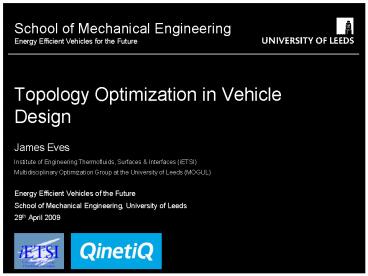Topology Optimization in Vehicle Design - PowerPoint PPT Presentation
1 / 11
Title:
Topology Optimization in Vehicle Design
Description:
... rather than density Minimizing drag of an object in an external flow Topology optimization of flow domains using the lattice Boltzmann method Georg Pingen ... – PowerPoint PPT presentation
Number of Views:1084
Avg rating:3.0/5.0
Title: Topology Optimization in Vehicle Design
1
Topology Optimization in Vehicle Design
School of Mechanical Engineering Energy Efficient
Vehicles for the Future
- James Eves
- Institute of Engineering Thermofluids, Surfaces
Interfaces (iETSI) - Multidisciplinary Optimization Group at the
University of Leeds (MOGUL) - Energy Efficient Vehicles of the Future
- School of Mechanical Engineering, University of
Leeds - 29th April 2009
2
School of Mechanical Engineering Energy Efficient
Vehicles for the Future
- Topology Optimization
- Optimization approach that differs significantly
from conventional ones - Used to determine the optimal distribution of
material within a design space - Density of each element in the designable space
is a design variable - Create designable space
- Apply load case
- Formulate problem
- Min. compliance
- Volume fraction lt 0.3
3
School of Mechanical Engineering Energy Efficient
Vehicles for the Future
- Why Topology Optimization?
- Conventional shape optimization requires a good
first design point. - Results in designs that are based on what has
been done before. - Topology optimization allows design concepts that
may not be intuitive.
Shape Optimization Topology Optimization
Topology optimization is a valuable tool for
generating conceptual designs. Traditional shape
and size optimizations are still important later
in the design process.
4
School of Mechanical Engineering Energy Efficient
Vehicles for the Future
Optimization of structural performance without
increasing mass
APPLICATIONS OF OPTISTRUCT OPTIMIZATION TO BODY
IN WHITE DESIGN Carl Reed Jaguar Cars Ltd.
5
School of Mechanical Engineering Energy Efficient
Vehicles for the Future
Optimization of aircraft wing ribs to reduce mass
and improve compliance
APPLICATION OF TOPOLOGY, SIZING AND SHAPE
OPTIMIZATION METHODS TO OPTIMAL DESIGN OF
AIRCRAFT COMPONENTS Lars Krog, Alastair Tucker
and Gerrit Rollema Airbus UK Ltd.
6
School of Mechanical Engineering Energy Efficient
Vehicles for the Future
- Topology Optimization of Flow Domains
- Very computationally expensive but attracting
increasing attention - Porosity of elements used as design variables
rather than density - Minimizing drag of an object in an external flow
Re1
Re100
Re10
Topology optimization of flow domains using the
lattice Boltzmann method Georg Pingen Anton
Evgrafov Kurt Maute Center for Aerospace
Structure, University of Colorado
7
School of Mechanical Engineering Energy Efficient
Vehicles for the Future
- Blended Wing Body Aircraft
- Wings and body blended together into a single
lifting surface. - Advantages
- Increased aerodynamic efficiency
- Increased payload
- Reduced noise impact
NASA X-48A (top) and Boeing X-48B (bottom)
8
School of Mechanical Engineering Energy Efficient
Vehicles for the Future
- Topology optimization used to determine optimal
position of spars in a conceptual BWB UAV design
supplied by QinetiQ Ltd. - Minimal compliance formulation
- Constraints on mass, wing tip displacement and
wing twist - Limitations of topology optimization
- Certain constraints difficult to implement
- Local deformation of wing skin
- Structural stability
9
School of Mechanical Engineering Energy Efficient
Vehicles for the Future
- Shape Optimization
- Average rib spacing of 2 feet used as initial
design point - Rib positions and orientations optimized to
maximize buckling load factor
- Topology Optimization
- Introduction of additional load cases allows
local and global deformation of the wing to be
considered. - Distributed material works with non-designable
ribs to improve stiffness.
10
School of Mechanical Engineering Energy Efficient
Vehicles for the Future
- Interpretation as Spars Ribs
- Results from shape and topology optimization used
to build a FEM of the aircrafts structural layout
- Size Optimization
- Thicknesses of spars, ribs and wing skin
optimized to minimize mass - Optimization procedure gives 10 mass reduction,
contributing to increased efficiency
11
School of Mechanical Engineering Energy Efficient
Vehicles for the Future
- Any Questions?

